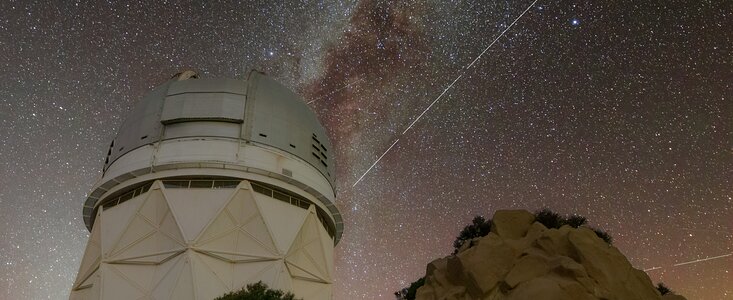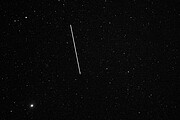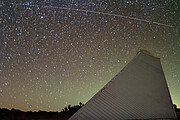IAU, NOIRLab, and SKAO Statement on BlueWalker 3
Global astronomy community troubled by unprecedented brightness and possible radio-astronomy impact of recently launched BlueWalker 3 satellite
2 December 2022
The International Astronomical Union, NSF’s NOIRLab, and the SKA Observatory unite to express their concern about the recently launched prototype BlueWalker 3 satellite’s impact on astronomy. New measurements reveal that this low Earth orbiting satellite is now one of the brightest objects in the night sky, outshining all but the brightest stars. In addition, the satellite’s use of terrestrial radio frequencies poses a new challenge to radio astronomy.
On 10 September 2022 AST SpaceMobile launched a prototype satellite called BlueWalker 3, which is operating under an experimental license, into low Earth orbit. This satellite, which has a 64-square-meter (693-square-foot) antenna system (the largest commercial antenna system ever deployed into low Earth orbit), is the first of what is expected to be more than a hundred similar or even larger satellites.
New measurements by observers worldwide, coordinated by the International Astronomical Union’s CPS (IAU Center for the Protection of the Dark and Quiet Sky from Satellite Constellation Interference), show that this satellite has become one of the brightest objects in the night sky — more so than other constellation satellites and at times as bright as some of the most recognizable stars [1].
Besides their visible brightness, these new satellites, which serve as “cell phone towers in space,” will transmit strong radio waves at frequencies currently reserved for terrestrial cell-phone communications. These orbiting transmitters, which are not subject to the same radio quiet zone coordination requirements and restrictions [2] as ground-based cellular networks, have the potential to severely impact radio astronomy research as well as geodesy studies and space-physics experiments.
The IAU and its CPS co-hosts, NOIRLab and the SKA Observatory (SKAO), are concerned about the impact these satellites will have on fundamental research and humanity’s ability to experience the natural night sky.
“Astronomers build radio telescopes as far away as possible from human activity, looking for places on the planet where there is limited or no cell phone coverage. Frequencies allocated to cell phones are already challenging to observe even in radio quiet zones we have created for our facilities. New satellites such as BlueWalker 3 have the potential to worsen this situation and compromise our ability to do science if not properly mitigated,” said SKAO Director-General Philip Diamond. “This is a key reason why the SKAO is deeply involved in the IAU CPS and promoting the equitable and sustainable use of space.”
The night sky is a unique laboratory that allows scientists to conduct experiments that cannot be done in terrestrial laboratories. Astronomical observations have provided insights into fundamental physics and other research at the boundaries of our knowledge and changed humanity’s view of our place in the cosmos. The pristine night sky is also an important part of humanity’s shared cultural heritage and should be protected for society at large and for future generations.
“BlueWalker 3 is a big shift in the constellation satellite issue and should give us all reason to pause,” said Piero Benvenuti, Director of the IAU CPS.
NOIRLab Director Patrick McCarthy said: “The growing encroachment of artificial sky glow from urban areas has already had a dramatic effect on humanity's intimate connection to the night sky. The addition of large numbers of bright artificial satellites further limits our ability to conduct research in astronomy and is a cause of alarm for people around the globe. We need close cooperation between industry, governments, and the scientific community to find technical and regulatory solutions that will allow the satellite-service providers to meet their objectives while protecting the night sky for astronomy and the enjoyment of future generations.”
The IAU and CPS partners recognize that the new satellite constellations have an important role in improving worldwide communications. However, their interference with astronomical observations could severely hamper progress in our understanding of the cosmos. Their deployment should therefore be conducted with due consideration of their side effects and with efforts made to minimize their impact on astronomy.
To better understand the effects of these new satellites, the IAU CPS invites further observations of BlueWalker 3. Visual and telescopic observations of BlueWalker 3 can be submitted online to SatHub, a worldwide public observing initiative of the IAU CPS.
Earlier this month, the FCC announced its intention to create an office dedicated to space, to better deal with this rapidly emerging issue, an action that the IAU CPS applauds.
Conversations between the IAU CPS and AST SpaceMobile have started. The IAU CPS fosters dialogue and cooperation between satellite operators and scientists. Recent discussions with some operators have led to mitigation measures but much more work is needed.
Notes
[1] The measurements show that BlueWalker 3 is around apparent visual magnitude 1 at its brightest — almost as bright as Antares or Spica (the 15th and 16th brightest stars in the night sky). Apparent magnitude in astronomy is a measure of the brightness of a star or other astronomical object as observed from Earth. The scale is reverse logarithmic: the brighter an object is, the lower its magnitude number. The brightest astronomical objects have negative apparent magnitudes: for example, Venus at −4.2 or Sirius at −1.46. The faintest stars visible with the naked eye on the darkest night have apparent magnitudes of about +6.5.
[2] There are several areas around the globe that have special protections for radio astronomy that prescribe how fixed radio transmitters can be used so they do not interfere with astronomical observations. The United States National Radio Quiet Zone is a 13,000 square mile (34,000 square kilometer) region in which broadcast antennas must operate at reduced power and use highly directional antennas.
More information
NSF’s NOIRLab(National Optical-Infrared Astronomy Research Laboratory), the US center for ground-based optical-infrared astronomy, operates the International Gemini Observatory(a facility of NSF, NRC–Canada, ANID–Chile, MCTIC–Brazil, MINCyT–Argentina, and KASI–Republic of Korea), Kitt Peak National Observatory (KPNO), Cerro Tololo Inter-American Observatory (CTIO), the Community Science and Data Center (CSDC), and Vera C. Rubin Observatory(operated in cooperation with the Department of Energy’s SLACNational Accelerator Laboratory). It is managed by the Association of Universities for Research in Astronomy (AURA) under a cooperative agreement with NSF and is headquartered in Tucson, Arizona. The astronomical community is honored to have the opportunity to conduct astronomical research on Iolkam Du’ag (Kitt Peak) in Arizona, on Maunakea in Hawai‘i, and on Cerro Tololo and Cerro Pachón in Chile. We recognize and acknowledge the very significant cultural role and reverence that these sites have to the Tohono O'odham Nation, to the Native Hawaiian community, and to the local communities in Chile, respectively.
The IAU is the international astronomical organization that brings together more than 12 000 active professional astronomers from more than 100 countries worldwide. Its mission is to promote and safeguard astronomy in all its aspects, including research, communication, education and development, through international cooperation. The IAU also serves as the internationally recognised authority for assigning designations to celestial bodies and the surface features on them. Founded in 1919, the IAU is the world's largest professional body for astronomers.
The SKAO, formally known as the SKA Observatory, is an inter-governmental organisation composed of Member States from five continents. Its mission is to build and operate cutting-edge radio telescopes to transform our understanding of the Universe, and deliver benefits to society through global collaboration and innovation. Headquartered in the UK, its two telescope arrays will be constructed in Australia and South Africa and be the two most advanced radio telescope networks on Earth. Through the development of innovative technologies and its contribution to addressing societal challenges, the SKAO will play its part to address the United Nations’ Sustainable Development Goals and deliver significant benefits across its membership and beyond. The SKAO recognises and acknowledges the Indigenous peoples and cultures that have traditionally lived on the lands on which the SKAO facilities are located.
Links
- CPS website: https://cps.iau.org/
- IAU Press Release: https://www.iau.org/news/pressreleases/detail/iau2211/
Contacts
Siegfried Eggl
Co-Lead, Sathub, University of Illinois at Urbana-Champaign
Email: eggl@illinois.edu
Mike Peel
Co-Lead, Sathub, Instituto de Astrofísica de Canarias
Email: mpeel@iac.es
Piero Benvenuti
Director of the IAU Centre for the Protection of the Dark and Quiet Sky from Satellite Constellation Interference
Email: piero.benvenuti@cps.iau.org
Constance E. Walker
NSF’s NOIRLab
Co-Director of the IAU Center for the Protection of Dark and Quiet Sky from Satellite Constellation Interference
Email: connie.walker@noirlab.edu
Federico Di Vruno
Co-Director of the IAU Centre for the Protection of the Dark and Quiet Sky from Satellite
Constellation Interference, SKAO
Email: federico.divruno@cps.iau.org
Charles Blue
Public Information Officer
NSF’s NOIRLab
Tel: +1 202 236 6324
Email: charles.blue@noirlab.edu
Lars Lindberg Christensen
IAU Director of Communications
Tel: +1 520 461 0433/+49 173 38 72 621
Email: lars.christensen@noirlab.edu
William Garnier
Director of Communications, Outreach and Education, SKA Observatory
Email: William.Garnier@skao.int
Stephanie C Doster
University of Arizona
Email: scdoster@arizona.edu
Jeremy Tregloan-Reed
Director of CLEOsat
Universidad de Atacama
Email: jeremy.tregloan-reed@uda.cl
Eduardo Unda-Sanzana
Director of Centro de Astronomía (CITEVA)
Universidad de Antofagasta
Email: eduardo.unda@uantof.cl
Debra Levey Larson
University of Illinois
Email: dlarson@illinois.edu











